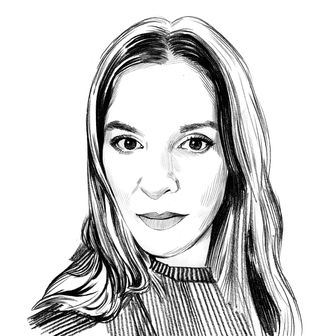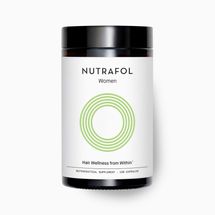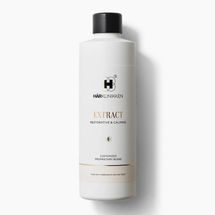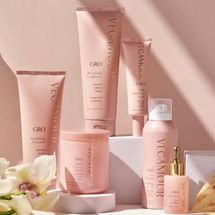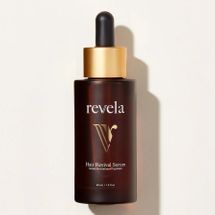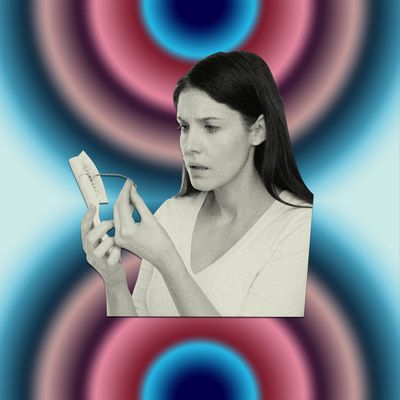
Hi, Jenn!
I’m a 34-year-old female who is wondering about Rogaine. I’ve been noticing thinning in my hair and had the idea to try it out for a while. But no one ever talks about it, so I’m wondering if it even works. If it helped, wouldn’t I hear about it at least a little? The algorithm seems to know everything else I’m thinking!
—Jessie
Jessie, I feel for you. Hair loss and hair thinning are tricky issues to treat. But you’re a woman of action! You noticed a problem and you’ve already got a solution in mind: Rogaine. It may not have the sexy-baby appeal of hair-growth gummies, or the Silicon Valley-adjacent vibe of laser combs, but Rogaine, aka topical minoxidil, does promote hair growth. There’s also evidence that taking a very low dose of oral minoxidil, in tablet form, can help to improve female-pattern hair loss. (Oral minoxidil is an off-label usage, so definitely talk to a doctor if you’re interested in that.) As for the topical form, Rogaine, you probably don’t hear about it that often because other treatments may be easier to use consistently. I’ll explain.
Rogaine is the brand name for minoxidil, the only nonprescription treatment for hair loss (it’s believed to increase blood flow to the scalp and decrease the resting phase of the hair cycle). But it can take three to six months of daily use to see results, and it’s not a permanent solution. “Rogaine works only when you use it; when you stop using it, it stops working,” says Julie Russak, M.D., founder of the Russak Dermatology Clinic. “You basically lose all the gains that you’ve had with it.”
So what? you may be thinking. If it helps, I’ll keep using it! Well, it’s not exactly user-friendly. For example, Women’s Rogaine 5% Minoxidil Unscented Foam works best if applied before styling hair. You must section your hair to massage it directly into your scalp, and some of the product will inevitably end up on your strands. “A complaint I often get is that it gives the hair a greasy, crunchy-looking appearance,” says Connecticut dermatologist Kim Nichols, M.D., founder of NicholsMD. To mitigate that side effect, she tells her patients to use it at night and apply it precisely with a cotton swab. But it can still build up on the hair if you don’t shampoo frequently. Nichols says she sometimes prescribes an oil-based minoxidil prescription for her patients with curly hair texture, but that can affect styling, too. (Plus, it’s unavailable over the counter and may need to be special-ordered from a compounding pharmacy.)
I’m not mentioning all of this to dissuade you from starting Rogaine! But if you want to be super-proactive about your situation, I suggest you head to a dermatologist for an evaluation, including blood tests that can determine if you have hormonal or nutritional imbalances or an underlying illness (such as alopecia areata) that could contribute to your hair thinning. Even if a dermatologist thinks that your hair loss is related to something that’s not detected in blood tests, like stress or aging (female-pattern hair loss can begin as early as your 20s), they can recommend a treatment plan. “Hair loss is a multifactorial process, and it usually takes multiple tools and a holistic approach to treat it,” says Russak.
But let’s get real. You probably already know that hair loss is difficult to treat, and sometimes you just don’t want to deal with the hassle of seeing a dermatologist. So now that I’ve gotten the WebMD portion of the answer out of the way, I’ll tell you what I tell my friends: Take Nutrafol. It’s one of the few supplements shown to promote hair growth in a placebo-controlled, peer-reviewed study. Nichols says she recommends it to all her patients, and Russak calls it “fantastic.” You can read more about how it works here, but the quickie explanation is that it contains nutrients, such as bio-optimized curcumin and saw palmetto, that can reduce micro-inflammation and inhibit the production of dihydrotestosterone (DHT), a hormone that exacerbates hair loss and hair thinning. (As a reminder, make sure you check with your doctor before taking any supplements!)
My other suggestion is to look into the hair-growth systems from Harklinikken and Vegamour, and the serum from Revela. Those are the brands I hear about most often from hairstylists and my podcast listeners — and they’re the ones I’ve vetted myself and feel good about recommending. They are also pleasant to use, which means you may stick with them longer than the Rogaine. Because there’s really only one thing that guarantees success with a hair-loss treatment, and that’s consistency.
Hair-Loss Treatments
Jennifer Sullivan answers all your beauty-related questions with practical advice and zero judgment. Send your questions to [email protected]. (By emailing, you agree to the terms here.)
More Beauty Advice
- How Do I Prevent Botox Immunity?
- Do Perfume Oils Last Longer Than Sprays?
- How to Layer Your Skin-Care Products in the Right Order


